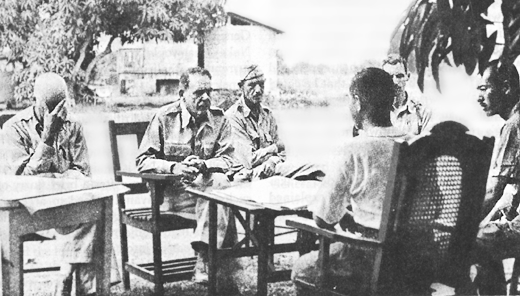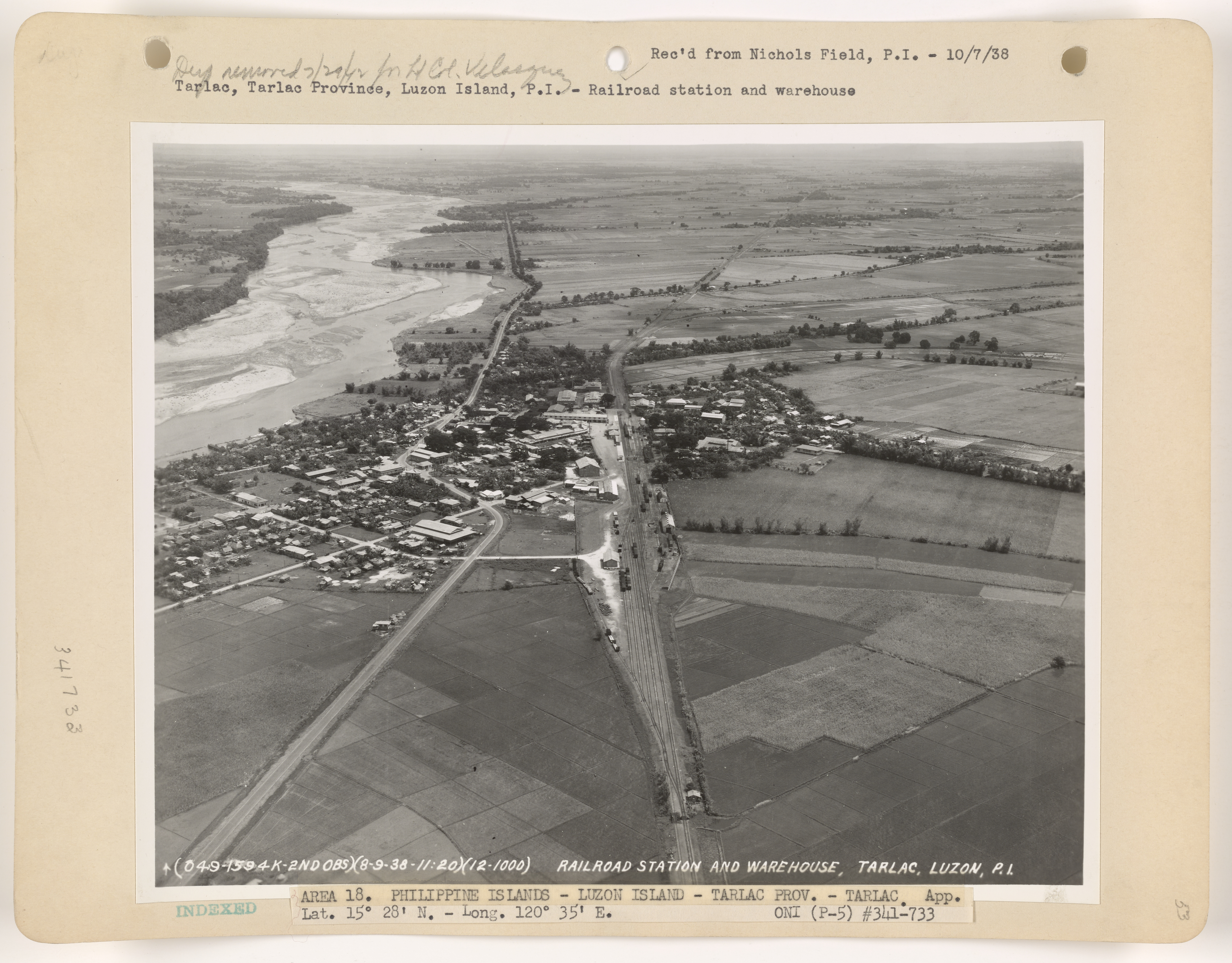|
Camp O'Donnell
Camp O'Donnell is a former United States military reservation in the Philippines located on Luzon island in the municipality of Capas in Tarlac. It housed the Philippine Army's newly created 71st Division and after the Americans' return, a United States Army camp. During World War II, the reservation was used as a prisoner-of-war camp for Filipino and American soldiers captured by Japan during its successful invasion of the Philippines. About 60,000 Filipino and 9,000 Americans were housed at the camp. During the few months in 1942 that Camp O'Donnell was used as a prisoner-of-war camp, about 20,000 Filipinos and 1,500 Americans died there of disease, starvation, neglect, and brutality. After World War II, it became a base of the United States Air Force and the location of the U.S. Naval Radio Station, Tarlac, with the Philippine Army installation occupying its eastern side. It housed the Training and Doctrine Command's Philippine Army Officer Candidate School, NCO Academy, an ... [...More Info...] [...Related Items...] OR: [Wikipedia] [Google] [Baidu] |
Bataan Death March
The Bataan Death March (Filipino: ''Martsa ng Kamatayan sa Bataan''; Spanish: ''Marcha de la muerte de Bataán'' ; Kapampangan: ''Martsa ning Kematayan quing Bataan''; Japanese: バターン死の行進, Hepburn: ''Batān Shi no Kōshin'') was the forcible transfer by the Imperial Japanese Army of between 60,000 and 80,000 American and Filipino prisoners of war from Saysain Point, Bagac, Bataan and Mariveles to Camp O'Donnell, Capas, Tarlac, via San Fernando, Pampanga, the prisoners being forced to march despite many dying on the journey. The transfer began on April 9, 1942, after the three-month Battle of Bataan in the Philippines during World War II. The total distance marched from Mariveles to San Fernando and from the Capas Train Station to Camp O'Donnell is variously reported by differing sources as between . Sources also report widely differing prisoner of war casualties prior to reaching Camp O'Donnell: from 5,000 to 18,000 Filipino deaths and 500 to 650 American death ... [...More Info...] [...Related Items...] OR: [Wikipedia] [Google] [Baidu] |
Officer Candidate School - Philippines
The Armed Forces of the Philippines Officer Candidate School (OCS; fil, Paaralang Kandidato Opisyal ng Sandatahang Lakas ng Pilipinas), formerly known as the School for Reserve Commission, is a military school located at Camp O'Donnell, Capas, Tarlac for the Philippine Army Officer Candidate School; Fernando Air Base in Lipa City, Batangas for the Philippine Air Force Officer Candidate School; and Naval Station Leovigildo Gantioqui in San Antonio, Zambales for the Philippine Navy Officer Candidate School. It was established in the Philippines for training future officers of the Armed Forces of the Philippines (AFP). The School trains civilians and enlisted personnel holding a baccalaureate degree for the officer candidate course (OCC); one-year leadership and management graduate course which prepares an officer candidate (OC) with a rank of Probationary Second Lieutenant and Probationary Ensign to be mentally, physically and emotionally fit to earn a commission as an officer in ... [...More Info...] [...Related Items...] OR: [Wikipedia] [Google] [Baidu] |
Electronic Warfare
Electronic warfare (EW) is any action involving the use of the electromagnetic spectrum (EM spectrum) or directed energy to control the spectrum, attack an enemy, or impede enemy assaults. The purpose of electronic warfare is to deny the opponent the advantage of—and ensure friendly unimpeded access to—the EM spectrum. EW can be applied from air, sea, land, and/or space by crewed and uncrewed systems, and can target communication, radar, or other military and civilian assets. The electromagnetic environment Military operations are executed in an information environment increasingly complicated by the electromagnetic spectrum. The electromagnetic spectrum portion of the information environment is referred to as the electromagnetic environment (EME). The recognized need for military forces to have unimpeded access to and use of the electromagnetic environment creates vulnerabilities and opportunities for electronic warfare in support of military operations. Within the informat ... [...More Info...] [...Related Items...] OR: [Wikipedia] [Google] [Baidu] |
Teófilo Yldefonso
Teófilo E. Yldefonso (born Teófilo Yldefonso y de la Cruz; November 5, 1903 – June 19, 1942) was a Filipino breaststroke swimmer. He was the first Filipino and Southeast Asian to win an Olympic medal, and the first Filipino to win multiple medals. Early life Teofilo Yldefonso was born on November 5, 1903 in Sitio Bayog, Piddig, Ilocos Norte to Felipe and Aniceta Yldefonso. He was the second among three siblings. His mother died after giving birth to his younger brother, who died at a young age. The Yldefonso siblings taught themselves to swim at the Guisit River. Yldefonso joined 57th Infantry Regiment of the Philippine Scouts of the United States Army in 1922 upon turning 18 years old. It was with the military he was exposed to competitive swimming. Career Yldefonso began joining regional swimming meets in the 1923. Competing in the 200-meter breaststroke, he won multiple gold medals in the Far Eastern Games (1923, 1927, 1930, and 1934). He also stood out in the Phili ... [...More Info...] [...Related Items...] OR: [Wikipedia] [Google] [Baidu] |
Battle Of Corregidor
The Battle of Corregidor (; ), fought on May 5–6, 1942, was the culmination of the Japanese campaign for the conquest of the Commonwealth of the Philippines during World War II. The fall of Bataan on April 9, 1942, ended all organized opposition by the U.S. Army Forces Far East to the invading Japanese forces on Luzon, in the northern Philippines. The island bastion of Corregidor, with its network of tunnels and formidable array of defensive armaments, along with the fortifications across the entrance to Manila Bay, was the remaining obstacle to the 14th Japanese Imperial Army of Lieutenant General Masaharu Homma. Homma had to take Corregidor, since as long as the island remained in American hands, the Japanese would be denied the use of Manila Bay, the finest natural harbor in the Far East. The U.S. Army, however, then successfully recaptured the island in 1945. Background Gibraltar of the East Corregidor, officially named Fort Mills, was the largest of four fortified ... [...More Info...] [...Related Items...] OR: [Wikipedia] [Google] [Baidu] |
Tarlac City
Tarlac City, officially the City of Tarlac ( pam, Lakanbalen ning Tarlac; pag, Siyudad na Tarlac; ilo, Siudad ti Tarlac; fil, Lungsod ng Tarlac ), is a 1st class component city and capital of the province of Tarlac, Philippines. According to the 2020 census, it has a population of 385,398 people. The city was proclaimed as a highly urbanized city by the former President Gloria Macapagal Arroyo, but the decision was opposed by the provincial government. History Tarlac's first settlers came from Bacolor, Pampanga. They cleared the area, fertilised the soil, and then established their settlement here in 1788. This small community of settlers experienced rapid population growth, as settlers from Bataan, Pampanga and Zambales moved into the area. The Kapampangan language, which is the dialect of Pampanga, became the native language of this town. Roads and barrios were built over the following decades through hard work of its residents. Following the foundation of the provinc ... [...More Info...] [...Related Items...] OR: [Wikipedia] [Google] [Baidu] |


_Unloaded.jpg)

